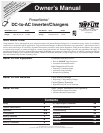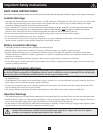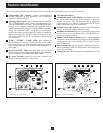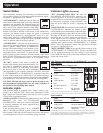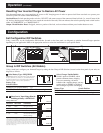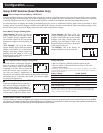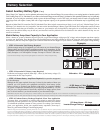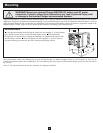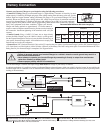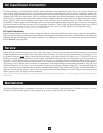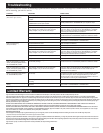
6
Select Battery Charger-Limiting Points
“Most Limiting” (B2&B1Up):Charger-
limiting takes effect the moment any AC
load isapplied;chargeroutputfalls gradu-
ally from full output at no AC load passing
through to no output at full load (factory set-
ting).
"Less Limiting" (B2 Up & B1 Down):
Charger-limiting begins when the Inverter/
Charger'sloadreaches33%oftheInverter/
Charger's load rating. Charger output falls
gradually from full output at 33% of the
Inverter/Charger'sloadratingtoabout33%
of full output at full load.
"Least Limiting" (B2 Down & B1 Up):
Charger-limiting begins when the Inverter/
Charger'sloadreaches66%oftheInverter/
Charger's load rating. Charger output falls
gradually from full output at 66% of the
Inverter/Charger'sloadratingtoabout66%
of full output at full load.
"No Limiting" (B2 & B1 Down): No
charger-limitingoccursatanyloadsize.
Configuration
(continued)
Group B DIP Switches (Select Models Only)
Select AC Input Current Sharing—OPTIONAL
Your Inverter/Charger features a high-output battery charger that can draw a significant amount of AC power from your utility source or genera-
torwhenchargingatitsmaximumrate.IfyourunitissupplyingitsfullACpowerratingtoitsconnectedheavyelectricalloadsatthesametime
as this high charging occurs, the AC input circuit breaker could trip, resulting in the complete shut off of pass-though utility power.
To reduce the chance of tripping this breaker, all Inverter/Chargers are pre-set to automatically limit the input current as described in "Most
Limiting" below. IfyourunitisequippedwithDIPswitchesB2andB1,theymaybeusedtoselectotherACinputcurrentsharingsettings.Verify
that AC input wiring is rated for the higher current that results when using the other settings.
B2
B1
Set Battery Charging Amps—OPTIONAL
Checkthenameplatelabelforyourunit’s
high- and low-charging amp options. By
setting on high charging, your batteries
willchargeatmaximumspeed.Whenset-
ting on low charging, you lengthen the life
of your batteries (especially smaller ones).
Battery Charger Switch Position
LowChargeAmps Up(factorysetting)
HighChargeAmps Down
CAUTION: When switching to the High Charge Amp setting, the user must ensure that the
amp-hour capacity of their battery system exceeds the amperage of the High Charge Amp
setting or the batteries may be damaged or degraded.
Select Equalize Battery Charge—OPTIONAL
ThisDIPSwitchismomentarilyengagedto
begin the process of equalizing the charge
stateofyourbattery’scellsbytime-limited
overchargeofallcells.Thiscanextendthe
usefullifeofcertaintypesofbatteries;con-
sult with your battery’s manufacturer to
determine if your batteries could benefit from this process. The charge
equalizationprocessisautomatic;oncestarted,itcanonlybestopped
by removing the input power.
Setting Procedure
• Moveto“Equalize”(DOWN)positionforthreeseconds.
• Moveto“Reset”(UP)positionandleaveitthere.Thisisthe
factory default setting.
CAUTION: Do not leave DIP switch B3 in the down position after beginning process. Battery
charge equalization should only be performed in strict accordance with the battery manufacturer’s
instructions and specifications.
Battery Charge Switch Position
Reset Up(factorysetting)
Equalize Down—momentarily
Connect Remote Control—OPTIONAL
All models feature an 8-conductor telephone style receptacle on the front panel for use with an optional remote control module (Tripp Lite model APSRM,
sold separately). The remote module allows the Inverter/Charger to be mounted in a compartment or cabinet out of sight, while operated conveniently from
the remote control module. See instructions packed with the remote control module.
B4
B3
B1B2B3B4
Reset
Equaliz
e
B1B2B3B4
B1B2B3B4
B1B2B3B4
B1B2B3B4
B1B2B3B4



